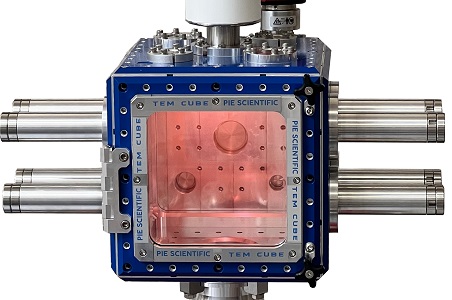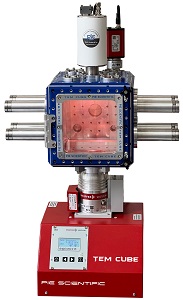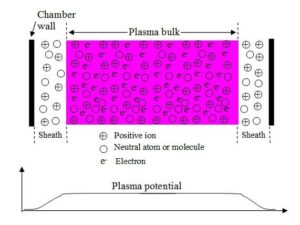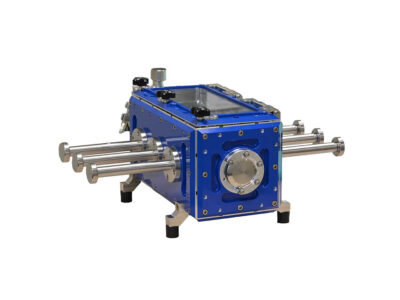Multi-purpose plasma chamber
TEM-CUBE can be used to store up to eight TEM specimen holders under a high vacuum (ultimate vacuum in the mid-10-7 Torr range). The vacuum level is high enough for leaking checking of in-situ TEM chips. TEM-CUBE can also be fitted with a remote EM-KLEEN plasma source to enable RF plasma cleaning in the chamber. The chamber is a 22.86cm x 22.86cm (9” X 9”) cube and can accommodate large TEM and SEM specimens and components. The chamber has a glass front door for process observation.
The standard pumping configuration is to place the chamber directly on a Pfeiffer turbo pump station (see option: PIE-HVS101). If high vacuum is not required, then the chamber can be pumped using a dry scroll pump, such as the Edwards nXDSi6 (A73501983). For details see: vacuum pumps.

- Large vacuum chamber 22.86cm x 22.86cm (9” X 9”)
- Storage of up to eight TEM specimen rods
- Option to fit EM-KLEEN plasma cleaner
- High vacuum and standard vacuum options
- Hinged front door with a glass observation window
- Cleaning SEM and TEM components (EM-KLEEN needed)
- Vacuum storage of specimens, components etc.
- Compact, space-saving design

TEM-CUBE: comparison with TEM rod storage system and Tergeo-EM plasma cleaner
In comparison with the PIE Scientific TEM rod storage system, each storage port on the TEM-CUBE cannot be individually vented or pumped because all the storage ports share the same vacuum chamber. It therefore takes a little longer to retrieve a TEM specimen holder as the whole chamber must be vented.
TEM-CUBE can be used for plasma cleaning TEM specimen holders and specimens, if the EM-KLEEN (PIE-EM100) plasma source is installed on the chamber. The EM-KLEEN plasma source has a single gas input, whereas the standalone Tergeo-EM plasma cleaner can take up to three process gasses. Venting and pumping times with TEM-CUBE are also longer than the Tergeo-EM plasma cleaner. Tergeo-EM also has fully automatic operation with a higher level of system integration.
For other instruments in the PIE Scientific range please see KLEEN and Tergeo
TEM-CUBE
Vacuum pump of your choice (click here for pump options)
EM-KLEEN plasma cleaner (click here)
Your choice of TEM rod adaptors (if required)
PIE-HVS102. TEM holder adaptor installed on the side (maximum 8X)
PIE-HVS103. Red-near Infrared lamp heating lamp
A73501983. Edwards nXDS6i dry scroll pump
PIE-EM100. EM-KLEEN RF plasma cleaner
- Vacuum chamber 22.86cm x 22.86cm (9” X 9”)
- Storage of up to eight TEM specimen rods
- Top and back plates with flange for installing optional pressure sensor and EM-KLEEN plasma cleaner
- Bottom plate can be ISO63 for turbo pump station option or blank plate for dry scroll pump option
- Left and right-side panels have four flange blanks that can be configured for different TEM holders (TEM holder adaptor are not included, please add option HVS102)
- High vacuum and standard vacuum options
- Hinged front door with a glass observation window
A radio frequency (RF) plasma is an ionised gas phase substance that consists of ions, electrons, and neutral atoms and/or molecules that grossly maintain charge neutrality. Electrons and ions should be close enough so that each of them can influence many nearby charged particles within a radius called the Debye screening length. As a result, charged particles in the RF plasma respond collectively to external electromagnetic fields. With a high density of free-moving ions and electrons, plasma is highly electrically conductive. With the exception of boundary regions between the plasma and electrodes, a plasma contains the same amount of positive and negative charges. There is no space charge within the bulk of the plasma.
Plasma sheath
Electron temperature is usually equal to or higher than that of ions. Since electrons are much lighter than ions, they can escape from a plasma at a much faster speed than ions, providing there is no confining potential barrier. Once electrons are nearly depleted from the boundary interface between the plasma and electrodes or specimen, a region with only positive ions and neutrals will be formed. This usually dark boundary region is called plasma sheath. Positive charges in the plasma sheath can push more ions to diffuse out of the plasma. It also creates a potential barrier to prevent electrons from diffusing out of the plasma. Eventually, the loss rate of electrons and ions will reach an equilibrium state. The plasma sheath also creates a positive plasma potential with respect to the grounded chamber walls. The voltage drop across the plasma sheath can accelerate ions and create an ion sputtering effect in many applications.
How an RF plasma is generated
Electrons and ions in plasmas can disappear through diffusion or recombination. To sustain a stable RF plasma, external excitation is required to create more electrons and ions so that their creation rate can reach a balance with the loss rate. Most RF plasma generation methods rely on heating free electrons to high enough energy to break down neutral atoms or molecules into ions and electrons.


